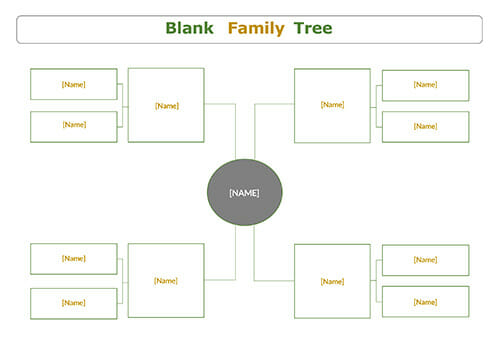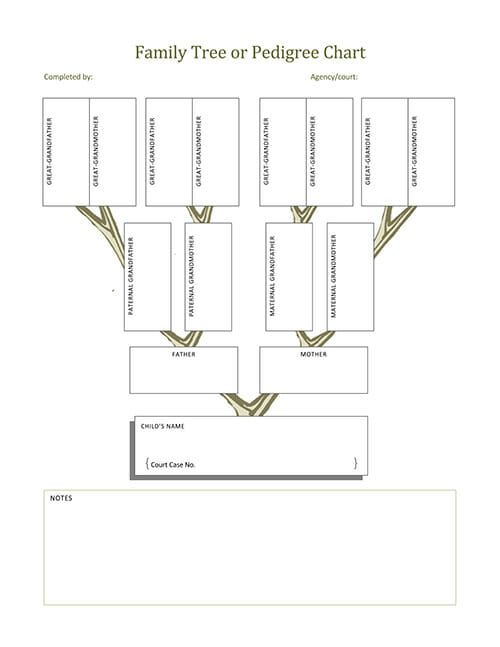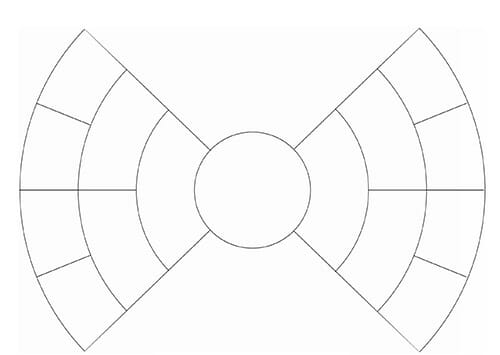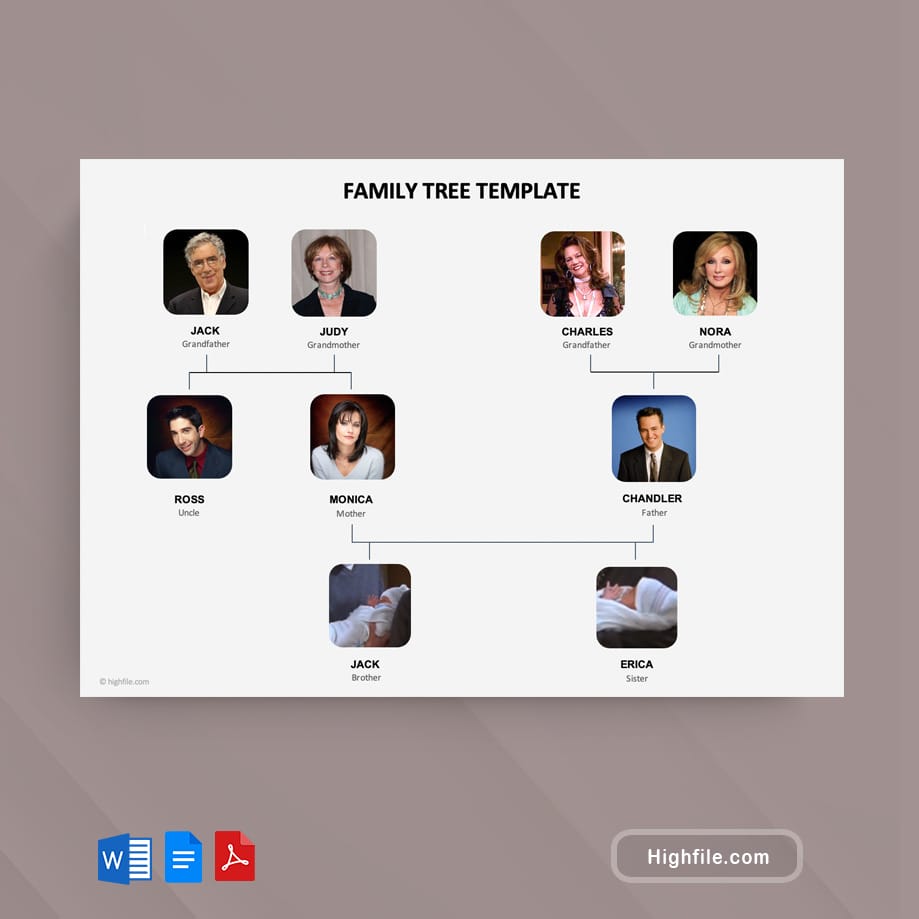A family tree is a visual representation that captures the lineage of multiple generations within a single family. This graphical chart effectively displays the relationships between family members, tracing back from the most recent descendants to their earliest known ancestors. By exploring a family tree, one can gain valuable insights into their family’s history, origins, and even the unique stories that shaped their ancestors’ lives.
Creating a family tree can be an enlightening and rewarding journey, allowing you to not only discover your roots but also to forge a deeper connection with your family’s past. To help you get started, we have compiled a collection of free family tree templates in Word, Excel, Google Docs and PDF formats. These templates are designed to be easily customizable, enabling you to document and share your family’s story in a visually appealing manner.
Family Tree Templates
What is a Family Tree Template?
A family tree template, also known as a pedigree chart or genealogy chart, is a comprehensive visual tool designed to map family relationships in a tree-like structure. These templates encompass not only names but also important details like birth and death dates, marriage information, and sometimes personal anecdotes or photographs. Available in various formats, from simple paper charts to interactive digital versions, these templates facilitate the exploration of familial connections and heritage. They serve as educational resources, particularly for younger generations, to learn about their ancestry and foster a sense of identity. Despite potential challenges like missing information or record discrepancies, creating a family tree is an enriching process that offers insights into one’s family history and helps build stronger bonds with both immediate and extended relatives.
Family Tree Templates & Examples
Below is a selection of diverse family tree examples and templates to help you begin your genealogical journey. These templates are available in both Word and PDF formats, ensuring a seamless and efficient experience as you document and explore your family history.
Simple Family Tree

- MS Word
Blank Family Tree Template

Family Tree Template (PDF)

Family Tree Outline

Family History Chart

Family Tree or Pedigree Chart

Blank 3 Generation Family Tree

4 Generation Family Tree Template (PDF)

4 Generation Family Tree Template (Word)

- MS Word
7 Generation Family Tree Template

Customizable Family Tree Template (Word)

- MS Word
Diagram of a Family Tree Template

Fillable Family Tree Template

- MS Word
Family Tree Simple Template

Ancestral Chart

Wuthering Heights Family Tree

More Family Tree Examples and Templates
Creating a family tree can be a fun and rewarding activity, but it can also be a daunting task without the right tools. Here are some more free family tree templates available in Word, Excel, and PDF formats that can make the process easier. These templates are not only printable but also simple and easy to customise. Whether you are just starting your family tree or want to update an existing one, these templates can help you organise your family history in a clear and visually appealing way.
Importance of a Family Tree
Understanding one’s family history and lineage through a family tree is not just an exercise in genealogy; it’s a journey into personal identity and collective history. A family tree offers a comprehensive overview of ancestry, going beyond names and dates to forge deeper connections with one’s heritage. This exploration into the past has numerous benefits that extend well beyond simple knowledge of lineage, playing a crucial role in bringing family members together, enhancing self-identity, and preserving cultural and familial legacies.
- Cultural and Historical Context: Integrate information about how family trees can connect individuals to their cultural and historical roots. This can provide a broader perspective on one’s identity and heritage.
- Educational Value for Younger Generations: Mention how family trees can serve as educational tools, especially for children, helping them understand their family’s place in history and the evolution of family dynamics over generations.
- Health and Genetic Information: Discuss how family trees can be instrumental in tracing genetic traits and medical histories, which can be crucial for understanding inherited health conditions.
- Preservation of Family Stories and Legacies: Highlight the role of family trees in preserving family stories, legacies, and traditions, ensuring that these valuable aspects of family heritage are not lost over time.
- Encouragement for Family Reunions and Gatherings: Explain how the process of creating a family tree can inspire family reunions and gatherings, creating opportunities for family members to share stories, reconnect, and strengthen bonds.
- Tool for Resolution of Familial Disputes: Briefly touch on the potential of family trees to resolve or provide clarity in familial disputes or inheritance issues, offering a clear lineage and connection between members.
Types of Family Tree Templates
Family tree templates come in various forms, each serving different purposes and offering unique insights into family histories:
- Ancestor Charts: These top-down charts showcase a person’s direct ancestors, ideal for tracing lineage and identifying familial patterns or trends.
- Descendant Charts: In contrast, descendant charts display an individual’s descendants in a bottom-up format, highlighting the breadth and branches of a family tree.
- Sandglass Diagrams: Merging ancestor and descendant charts, these templates resemble an hourglass, presenting both ancestors and descendants of a person, offering a comprehensive family view.
- Generation-Specific Trees (Three, Four, Five, and Six-Generation): These templates focus on a specific number of generations, like grandparents to grandchildren, perfect for detailing a particular family segment or for more compact family trees.
- Stepfamily Trees: Catering to blended families, these templates include step-relationships, acknowledging the importance of non-biological family bonds.
- Biographical Family Trees: Going beyond names and relationships, these templates incorporate biographical details like occupations or significant life events, adding depth to each family member’s story.
- Family Group Sheets: These sheets focus on a single family unit, providing detailed information about parents and children, including vital statistics like birth, marriage, and death dates.
- Relationship Charts: Useful for mapping out complex family connections, these charts visually demonstrate how different family members are related.
- Adoptive Family Tree Charts: These templates are designed for adopted individuals, incorporating both biological and adoptive family details, fostering a complete understanding of one’s familial roots.
Each type of template serves a unique purpose, whether it’s for understanding familial connections, preserving detailed biographical information, or acknowledging all members of a blended or adoptive family. Choosing the right template depends on the specific aspects of one’s family history one wishes to explore and document.
Benefits of Understanding the Family Tree
Understanding your family tree offers numerous benefits, both personally and practically. There are several advantages to exploring and understanding your family tree:
- Deepening connections to your heritage: Learning about your ancestors and their origins helps you better appreciate your cultural and familial roots. This can foster a strong sense of identity and pride in your heritage.
- Uncovering genetic and health-related information: Tracing your family lineage may reveal patterns of genetic traits or health issues. This information can help you and your healthcare provider make informed decisions about your health, lifestyle choices, and preventive measures.
- Fostering a sense of belonging: Knowing your roots and the stories of your ancestors can create a sense of connection to both your family and the larger historical context in which they lived. This can lead to a greater understanding of your place in the world and help you feel more grounded.
- Building valuable connections: Understanding your family tree can lead to the discovery of previously unknown relatives or connections. These new relationships may offer support, guidance, or opportunities in various aspects of life, including career, education, and personal growth.
- Preventing socially unacceptable relationships: Being aware of your family tree can help you avoid entering into inappropriate relationships, such as incestuous ones, by identifying potential family members and their respective connections to you.
- Preserving family history: Documenting your family tree is a way to preserve your family’s history and stories for future generations. It can serve as a valuable resource for your descendants and help them understand their own heritage and identity.
- Enhancing problem-solving and research skills: The process of researching and piecing together your family tree can sharpen your critical thinking and investigative abilities, as you navigate historical records, oral histories, and other sources of information.
How to Make a Family Tree Template
Creating a family tree template is a rewarding process that brings your family’s history to life. Follow these steps to craft your family tree:
- Define the Tree’s Scope: Decide on the complexity of your family tree. A simple tree might include immediate family and grandparents, while a more complex one could extend to distant relatives and ancestors.
- Gather Family Information: Begin by collecting details about your family members. Talk to parents, elder relatives, or refer to family records for accurate information.
- Organize the Data: Systematically arrange the information you’ve gathered, perhaps by generations or family branches. This organization will simplify the process of populating your family tree.
- Select a Template: Choose a family tree template that suits your needs. Options range from online templates to custom designs you can create with design software or even by hand.
- Populate the Template: Start filling in the template with your data. Begin with yourself, then add immediate family members, and gradually include more distant relatives in an orderly fashion.
- Verify the Details: Carefully review the information for accuracy. Consult family members to confirm details or fill in any missing pieces.
- Customize and Personalize: Enhance your family tree with personal touches like photographs, important dates, or anecdotes. Experiment with fonts, colors, and styles to make it visually appealing and reflective of your family’s story.
- Save and Share: Once your family tree is complete, save it in a suitable format, such as a digital file or a printout. Share it with family members, and preserve it as a historical document for future generations.
Creating a family tree is more than an exercise in genealogy; it’s an engaging way to connect with your heritage and share it with others.
Is there a family tree template on Word?
Yes, Microsoft Word offers a family tree template that you can use to create your own family tree. To create a family tree using Microsoft Word, follow these simple steps:
- Open Microsoft Word: Launch the Microsoft Word application on your computer.
- Access the SmartArt graphics: Click on the “Insert” tab in the top menu, and then select “SmartArt” from the options available. This will open the SmartArt graphics library.
- Choose a suitable hierarchy template: In the SmartArt graphics library, browse through the categories and select “Hierarchy.” This category contains various organizational chart templates that can be used as a family tree template. Choose a template that best suits your needs and click “OK” to insert it into your document.
- Customize the template: Once the template is inserted, you can customize its appearance by changing the layout, colors, and style. To do this, click on the SmartArt graphic, and the “SmartArt Design” tab will appear in the top menu. Use the options available in this tab to make any desired changes to the template.
- Add family members’ names: Click on a text box within the template to add the name of a family member. To insert additional text boxes, click on an existing text box, and then click the “Add Shape” option in the “SmartArt Design” tab. This will allow you to add more generations or branches to your family tree.
- Organize the family tree: Before entering names, decide on the number of generations you want to include and organize them accordingly. Ensure that family members from the same generation are at the same level in the template for a clear and consistent presentation.
- Save and share your family tree: Once you have completed your family tree, save the document in your desired format, such as a Word file or a PDF. You can then print, share, or store the file for future reference or to share with your family members.
How to Fill in Family Tree Template
Filling in a family tree template accurately and consistently can significantly enhance its clarity and usefulness. Here are some guidelines to help you effectively complete your family tree:
- Capitalize Surnames: Always write surnames in capital letters. This helps to easily distinguish them from given names and emphasizes their significance in the family lineage.
- Include Middle Names: Whenever possible, include middle names. This addition provides a fuller representation of each family member’s identity.
- Denote Nicknames Appropriately: When a family member is known by a nickname, place it in quotation marks following their given name, like James “Jim” Smith. This approach preserves formal names while acknowledging commonly used names.
- Use Maiden Names for Women: For female family members, use their maiden names instead of married names. This practice maintains lineage clarity and helps trace the family history more accurately.
- Consistent Date Formatting: Adopt a uniform date format across the template. The Day/Month/Year format (e.g., 12/04/1965) is often recommended for clarity.
- Uniform Location Formatting: Ensure locations are listed in a consistent manner. A format like City, County, State, Country (e.g., Austin, Travis, Texas, USA) is typically clear and informative.
- Add Life Events: Where relevant, include significant life events such as marriages, immigrations, or notable achievements. This information adds depth and context to the family history.
- Reference Historical Context: If applicable, add historical context that may have influenced your ancestors’ lives, like wars, migrations, or major societal changes.
- Use Symbols for Clarity: Employ common genealogical symbols, like ‘*’ for birth dates and ‘†’ for death dates. This standardization helps avoid confusion.
- Leave Space for Unknowns: It’s okay to leave blanks for unknown information. Over time, these gaps can be filled as more information becomes available.
Tips to Make a Family Tree
Creating a family tree is not only a journey into your past but also a rewarding experience that brings your family’s history to life. Here are some essential tips to guide you in building a successful family tree:
- Start with Known Information: Begin your family tree with yourself and your immediate family. This information is easily accessible and forms a solid foundation for expanding your family history.
- Engage with Extended Family: Reach out to extended family members like aunts, uncles, and cousins. They can be invaluable sources of information and may possess old documents, photographs, or family stories that can enrich your tree.
- Utilize Online Genealogy Resources: Dive into the wealth of information available on genealogy websites, forums, and databases. These platforms offer access to historical records, other family trees, and a variety of research tools, helping you piece together your family history.
- Cross-Check with Primary Sources: For accuracy, corroborate your findings with primary documents such as census records, birth, marriage, and death certificates. Many of these can be found online, sometimes for free or at minimal cost.
- Exercise Patience and Perseverance: Genealogical research can be a time-consuming process, often involving navigating incomplete records and unraveling hidden connections. Approach your research with patience and persistence, and remember that each discovery, no matter how small, is a significant addition to your family story.
- Organize Your Findings: Keep your research organized. Maintain a record of sources and information you uncover. This will help in cross-referencing data and keeping track of your progress.
- Include Personal Stories and Anecdotes: In addition to names and dates, enrich your family tree with personal stories and anecdotes. These elements bring life to your family tree, transforming it from a mere chart into a vivid narrative of your family’s history.
- Stay Open to Surprises: Be prepared for unexpected findings. Family research can sometimes reveal surprising connections or stories, adding depth to your understanding of your ancestry.
- Embrace Technology: Consider using genealogy software or online tree-building tools. These can streamline the organization of data and facilitate sharing and updating your tree.
- Share and Collaborate: Share your family tree with other family members. Collaboration can lead to new discoveries and ensures the preservation of your family history for future generations.
Things to Avoid
When creating a family tree, it’s essential to avoid certain pitfalls that may compromise the accuracy and usefulness of your final product. Here are some things to avoid when making a family tree:
- Relying on unreliable sources: Be cautious when consulting individuals who may provide inaccurate or incomplete information. Verify the details they provide with primary sources, such as official records, to ensure your family tree’s accuracy.
- Making typos or errors: Double-check names, dates, and other details to avoid introducing errors into your family tree. Mistakes can lead to confusion and misinterpretation of your family history.
- Fabricating or estimating ages: Avoid guessing or fabricating ages for family members. Instead, make an effort to find accurate age information through primary sources, such as birth or marriage records.
- Excluding family members due to personal biases: Do not omit family members from your tree based on personal preferences or disagreements. A comprehensive family tree should include all relatives, regardless of your personal feelings towards them.
- Including sensitive or private information: Be mindful of the privacy and security of your family members. Refrain from including sensitive details, such as physical addresses, financial information, or medical histories, in your family tree. This will help protect your family’s privacy and ensure that the family tree remains a valuable resource for future generations.
FAQs
Involving children in creating a family tree can be a fun and educational experience. You can start with simple activities like drawing a tree and placing family photos on it. Encourage them to ask questions about relatives and share stories, turning it into an interactive storytelling session.
Hitting a dead end is common in family research. When this happens, try reaching out to distant relatives, exploring local history resources, or taking a break and revisiting your research later. Sometimes, fresh eyes or new information can help break through the barrier.
Yes, privacy is important, especially when sharing information online. Avoid posting sensitive personal details of living relatives without their consent. Consider using privacy settings on genealogy websites to control who can see your family tree.
Yes, family tree research can be helpful in legal matters such as inheritance disputes or citizenship applications, especially when it’s necessary to prove relationships. However, legal cases often require official documents, so genealogical research should be supported with formal records.
Tracing immigrant ancestors can be challenging due to name changes, language barriers, and limited records. Researching the historical context of their immigration, exploring passenger lists, and connecting with genealogy groups from their country of origin can be helpful strategies.
Final thoughts
Crafting a family tree is more than just charting a lineage; it’s an invaluable endeavor for uncovering and preserving your family’s history, and it plays a pivotal role in fostering a deep sense of connection among family members. Delving into the lives of both immediate and distant relatives, you gain a rich and comprehensive understanding of your family’s unique connections and heritage. For parents, a family tree becomes an engaging educational tool, offering a tangible way to teach children about their ancestral origins and familial bonds. Ultimately, a well-crafted family tree serves as a testament to your family’s past, a beacon for its present, and a legacy for its future, weaving together the diverse threads of your family’s story into a cohesive and enduring narrative.



















![Family Tree for [Your Name]](https://www.docformats.com/wp-content/uploads/2021/11/Family-Tree-for-Your-Name.png)









